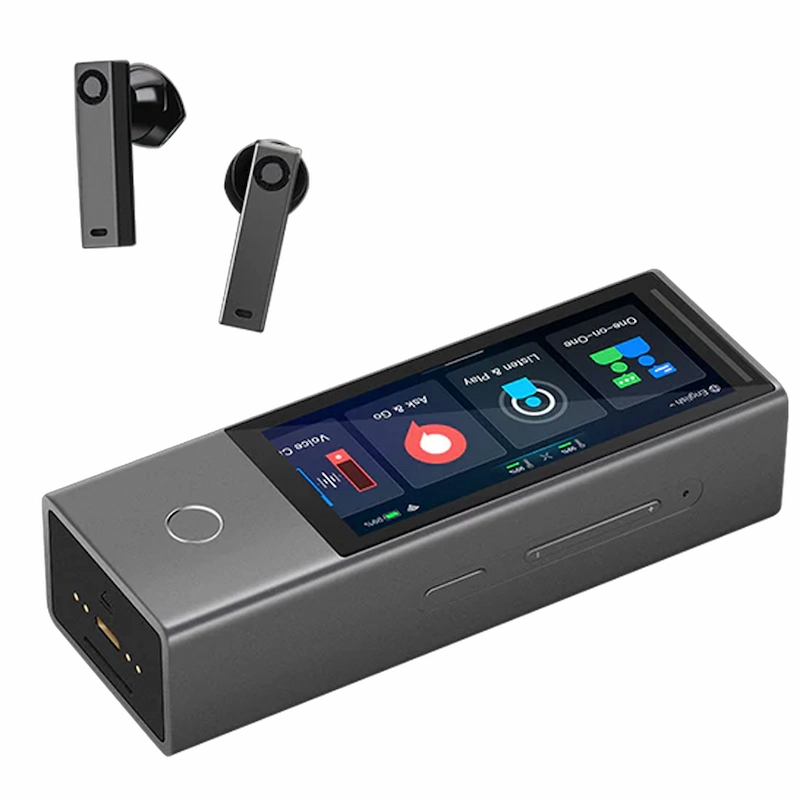
Translation accuracy
95%
Warranty
12 months
Updates
Yes
Number of languages
40
Number of translation engines
1
Manufacturer's technical support in English
User manual in English
Device menu in English
SIM card included
Free internet access period
Not applicable
Data plan renewal price
Not applicable
Number of countries where the SIM card works
Not applicable
Translation sharing option
Weight
570 g
Available colors
grey
Price
£699.99
Country of manufacturer
China
2
Place
Rating
8.5/10
Operates independently without requiring connection to a smartphone
Offers 13 offline language pairs, predominantly involving Chinese
Can establish a translation network, but only between X1 hubs
Expensive, with extra hubs needed for full functionality
In-ear design raises hygiene concerns, particularly when shared
Quite heavy build, weighing 570g
Timekettle X1 is an electronic translator with a central hub and wireless earbuds. It supports 40 languages online and 13 language pairs in offline mode, though these are mostly limited to combinations with Chinese. Features like Listen & Play and Ask & Go offer real convenience and are definite highlights. However, the device comes with a hefty price tag (around £700), which is made steeper by the need to pay extra for offline language packs (roughly £10 per pair) and additional hubs if you want to unlock the full range of functions. Other downsides include its weight (570g) and the lack of a built-in SIM card — though it does allow you to insert your own, which is a plus.
During unboxing the Timekettle X1, the first thing that stood out was its weight (570g), which feels rather heavy for a device designed to be portable. The hub itself feels well-built, but we had some concerns about the slide-out earbud compartment. The mechanism doesn’t inspire much confidence and may struggle to close properly with prolonged use.
Setting up the device was a bit of a chore — the initial configuration process was longer than expected and not particularly user-friendly. Another drawback is the Timekettle app, which only offers tutorials in four languages (English, Spanish, Chinese, and Japanese), potentially limiting accessibility for many users.
That said, once the setup is complete, the X1 runs smoothly and is intuitive to use. It’s a solid performer — once you’re past the fiddly beginning.
We tested all of the Timekettle X1’s available modes:
Listen & Play Mode – this is arguably one of the X1’s stronger features. In a business meeting, placing the hub on the table was enough to receive live translations directly in the earbuds. The quality of translation was generally good, though there was a slight delay when people spoke quickly.
Ask & Go Mode – also performed well. Holding down the button and speaking a phrase prompted a swift translation, which was then played back through the speaker.
One-on-One (1:1) Mode – designed for face-to-face conversations, this mode allows each person to wear one earbud. However, this is where we ran into a significant issue: sharing in-ear earbuds raises hygiene concerns, especially in public or professional settings. While the kit includes four interchangeable covers, that’s hardly enough for frequent use. Swapping and cleaning them was fiddly, and the two attachments intended to keep the earbuds secure were small, awkward to fit, and didn’t improve comfort.
Multi-Person Mode – we tested this with three X1 devices (as that’s all we had available), and it did allow for multilingual interaction. However, the main drawback is that only the host’s microphone is active by default, which means extra setup is needed to make the conversation flow naturally. On top of that, each participant must own their own X1 – and at around £700 per device, it’s simply not a practical solution for most group scenarios.
Voice Call Mode – this mode enables remote conversations, but only between X1 users. That’s a major limitation, as it’s unlikely the person you need to speak with will also have the same device.
We have to say, the online translation quality was impressive — the advertised 95% accuracy figure seems fairly accurate in real-world use. That said, we did notice some delays when dealing with longer or more complex sentences. Although the manufacturer highlights the use of AI-powered semantic segmentation to reduce such lag, in practice its performance was fairly average. The built-in noise reduction feature does a decent job of filtering out background sound, which made the device usable in a simulated business meeting held in a busy café. However, it definitely performs better in quieter surroundings.
The device supports 40 languages when connected online and offers 13 language pairs for offline use. However, in practice, we found that the offline options are mostly limited to combinations involving either Chinese or English as the base language. This considerably reduces their usefulness for users who don’t speak those languages fluently. Additionally, offline translation is only available in 1:1 and Listen & Play modes. One notable drawback is the lack of a built-in SIM card, meaning you’re reliant on Wi-Fi for online translation. This significantly affected the device’s portability during our tests abroad — especially in areas where internet access was limited or came at a high cost.
The Timekettle X1 clearly has potential, but a number of key drawbacks hold it back. The steep price tag (around £700), reliance on Wi-Fi for online translation (unless you add your own SIM – a definite plus for offering that option), and the need to purchase additional units for group conversation features make it a costly choice for an average user. Translation delays and awkward earbud ergonomics further limit its practicality. While modes like Listen & Play and Ask & Go function reasonably well, they’re not enough to compensate for the device’s core shortcomings.
Who is it for? Businesses, financially comfortable travellers, and dedicated language enthusiasts. Who is it not for? Anyone looking for a quick and affordable translation solution.
Copyright © 2025 translators-ranking.co.uk